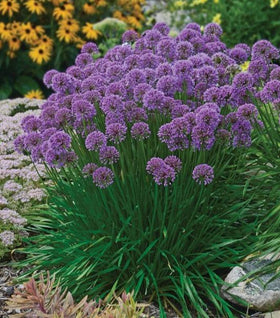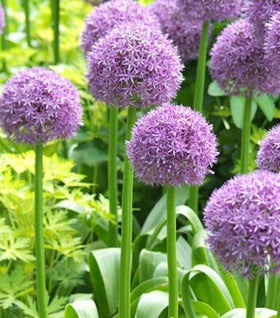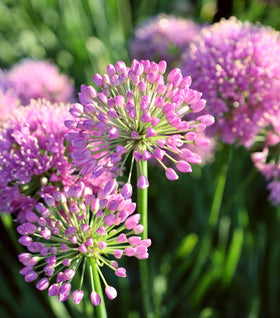Allium Plants for Sale Online
Alliums, Flowering Onion plants, produce orb-shaped flowerheads on tall thin stalks that almost seem to float above the garden. Pollinators visit allium plants throughout the flowering season. Alliums are also one of the most deer resistant perennials grown today.
These easy to grow, cold-hardy perennials can be used to add a whimsical almost Suess-like feel to otherwise dull-looking perennial plantings. Often seen in cottage gardens, planted along walkways, or grown in patio containers.
Alliums make a bold statement in the garden and are an excellent choice for the back of the perennial border due to their height. Once the blooms fade in early summer you can cut the flowers for dried arrangements or leave them standing in the garden. Alliums are sun-lovers and prefer well-drained soil. Typically allium bulbs are planted in the fall only but by buying potted alliums you can plant them any time of year without worry.
Planting Allium Plants
Allium plants grow best in full sun, but they will tolerate partial shade. They are hardy in zones 3 through 8, so northern gardeners can enjoy these spherical beauties. Alliums do need well-drained soil and will not tolerate soggy water-logged areas of the garden.
How to Plant Alliums
Allium bulbs are typically planted in the fall, but the varieties listed here are herbaceous alliums and develop fibrous root systems like other flowering perennials. These types of flowering onions can be planted at any time of year. Alliums are heavy feeders, so be sure to amend the soil with compost before planting.
Caring For Allium Plants after they Flower
When allium plants have finished flowering, you can remove the spent flower heads or leave them in place to dry. Many gardeners consider the seed heads to be an interesting ornamental feature, and they can often last into the fall.
Keep in mind Alliums need their foliage to produce energy for next year’s flowers since technically they are a bulb. It's important to allow allium foliage to die back naturally without being removed from the plant. Once it has withered and turned yellow, it can be removed from the plant.
How to use Flowering Alliums in the Garden
Perennial Garden or Mixed Border: Alliums bloom in late spring. The flowers last for weeks and seem to hover over the garden like pink or blue orbs. After they flower, both the flowers and leaves fade away and are typically covered by other herbaceous perennials. Since they take up very little room, they can be mixed with other plants without worrying about fighting for space.
Cottage Gardens or Cutting Gardens: Alliums make excellent cut flowers. The rigid stems make them easy to arrange in bouquets, and the flowers are very long-lasting. Planting different types of allium plants in the cutting garden will ensure you always have various alliums for your arrangements. They can also be used in dried arrangements by allowing them to dry in the garden or hanging upside down in a cool, dry space.
Mixed Containers or Patio Pots: Alliums will do well in containers. They can be planted by themselves or used as a centerpiece for mixed containers. Keep in mind the Allium plants will go dormant in the summer, so plant things to fill the space.
How to Divide Allium Plants
Alliums are late-spring-blooming bulbs that go dormant in summer. In the summer, allium plants are lifted and divided. Dig around the clump and lift the plant. Alliums are easily pulled apart by hand and rarely need to be cut apart. After dividing, replant the divisions anywhere in the garden, careful not to plant them deeper than they were originally planted.



